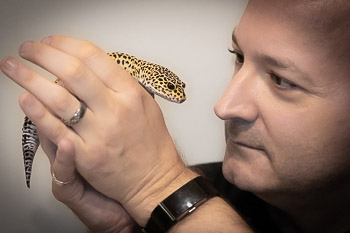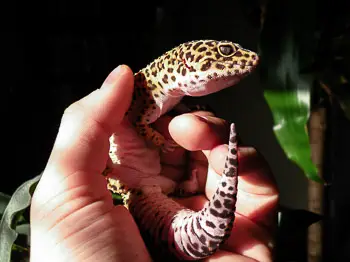You’ll commonly see a tank full of leopard geckos for sale in most of your large chain pet stores, often piled on top of each other vying for the best hiding places. When seeing this scenario in pet shop after pet shop, it may seem that it’s perfectly fine for leopard geckos to be kept together.
However, these are usually smaller juvenile leopard geckos that you see kept together in pet stores. They don’t take up as much space in the tanks or in the hides. Furthermore, under the circumstances, these lizards don’t have a choice. They’ve got to sit and sleep somewhere, and if there is only one space in the tank, it’s going to be overcrowded.
This isn’t natural. In Nature, leopard geckos are solitary creatures. This means they typically do not choose to live in groups. They’ll prefer much the same in captivity. Sure, they get together to mate, but it’s not like they have cozy little family units.
You’ll want to take a few things into consideration if you’re planning to have leopard geckos kept together:
- Leopard Gecko Sex
- Leopard Gecko Size
- Enclosure Size
- Leopard Gecko Health
Let’s break each one of these areas down and detail the thoughts and concerns for each factor.
Sex Matters
As leopard geckos become sexually mature, their sex affects how well they play together when sharing the same space.
Male/Male

Housing two male leopard geckos together is generally a bad idea. They can be territorial, and will very likely fight. Fighting between two males can result in injuries. It’s not uncommon for a leopard gecko to not only lose the fight, but frequently lose its tail as well.
Female/Female

Two females is the safest combination if you’re keeping multiple leopard geckos in the same enclosure. They generally won’t cause problems with each other. Even so, make sure each of your geckos has enough room and enough hiding places.
You’ll still want to keep their relative size in consideration. If one is significantly larger than the other, the bigger one may dominate the tanks as well as the food supply.
Male/Female

Only put a male and female together if you want to breed them. Keep in mind that a female can produce eggs up to 8 times per mating season, and repeated egg production causes stress on the body and will ultimately reduce her lifespan. If you’re housing a male and female together, consider how many eggs or baby geckos you’re ready for.
When not breeding, males and females should be kept separately. If your intent is to breed leopard geckos, it is best to house a single male with several females. Not only will this increase your egg production, it will reduce the strain on a single female. You’ll want to increase your tanks size accordingly.
Leopard Gecko Size
Regardless of gender, a larger leopard gecko may monopolize the food supply. This could not only stunt the smaller gecko’s growth, but will cause undue stress as it tries to get to the food but is denied by its dominant tank mate.
Related Post: How Big do Leopard Geckos Get?
Enclosure or Tank Size
A 20 gallon tank should be the minimum size if you’re housing two (or more) leopard geckos together. Both geckos will want a hot and cool hide, and your tank will quickly become cramped.
When housing multiple leopard geckos, usually bigger is better. You’ll want to give them room to spread out and have their own territory and space.
Keep in mind that larger tanks are going to need ample heat. You still want a hot and cool side with a variance of the upper 70’s on the cool side to 90 degrees on the hot side. If you go big on the tank, make sure you plan your heating to maintain the temperature.
Leopard Gecko Health
If you have multiple leopard geckos residing in the same space and one becomes sick, you’ll want to isolate the sick lizard for several reasons. (If you’re unsure, check our article on how to tell if your gecko is sick.)
First, you don’t want the sickness to spread to other geckos. It’s best to treat your sick gecko away from the others as not to affect the healthy ones, and also let the sick gecko have a better chance to get better.
Second, survival of the fittest. Your sick gecko may become a target for others. If nothing else, the healthy geckos can dominate the food supply, and the sick gecko will not have the strength to dominate. Lack of food will worsen the sick gecko’s condition.
Wrap Up: Should leopard geckos be kept together?
Leopard geckos generally prefer to live alone. If a male and female leopard gecko are kept together, their natural instinct is to breed. When two male leopard geckos are kept together, their natural instinct is to fight. You can read more in our post about leopard gecko fighting.
When housing multiple leopard geckos together, it’s wise to monitor their behavior and separate them if necessary.
You’ll want to plan your leopard gecko habitat with ample space to keep all of your pets healthy and happy.
Can you keep leopard geckos with other species? Read to find out if leopard geckos can live with anoles, crested geckos, or bearded dragons.





